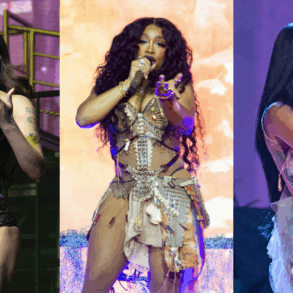
I was six years old when a family member told me that girls at school would be mean to me because I have light skin. Shortly after, I was warned about girls who would be jealous because of my hair. Soft and loose curled hair have been historically considered “good” hair. By the middle of second grade, my friends (that my family swore were jealous of me) and I sat in the living room after school every day singing and dancing and watching videos on YouTube. One of our favorite songs was “Every Girl” by Young Money. “I like a long haired thick redbone,” Lil Wayne raps at the start of the song. At the time, I had no idea what a “redbone” was. Certainly, the lyrics were too advanced for our eight-year-old ears — but that isn’t the point. The term “redbone” is defined in the Urban Dictionary as a “female or male of African American descent who is light skinned with red undertones.” My family members were wrong; my friends weren’t jealous of me, but their assumptions were reasonable. Their assumptions have been perpetuated for generations.
The idea that dark-skinned African American women harbor jealousy of light-skinned African American features is deeply rooted in racism. The universal racial hierarchy deems white, the lightest of all skin tones, at the top and everything else below. Within African American culture, a similar type of hierarchy exists, placing light-skinned Black people at the top, brown-skinned Black people in the middle, and dark-skinned Black people at the bottom. Colorism describes the phenomenon of favoring lighter-skinned individuals over darker-skinned individuals in the Black community. It derives from the racist belief, a result of American slavery, that white people are superior to Black people and has been upheld generationally, creating horrible consequences for dark-skinned Black people.
The origin of colorism dates to the beginning of the transatlantic slave trade in the 17th century. Africans were seen as inferior in the eyes of the Western world when they were forced into North America. They had two roles. First, to work on plantations under white slave masters. Second, to take on the identity of “rawness and savagery” so their white counterpart could take on the identity of purity and gentleness. Being property instead of human and doing the grunt work to hold up the rest of society was justified by the Western belief that Black people were animalistic. Animalistic traits attributed to Blackness created the purity of whiteness because Westerners now had something distinguishable, making the Black race the “other.” The existence of a Black slave population in North America allowed for white people to take on the identity of the superior race.
As slavery continued to thrive in America, so did the beliefs that supported it. Lighter-skinned slaves, who were usually conceived by masters sexually assaulting Black women, were always granted more privileges than darker slaves. They worked primarily in the house and therefore had more opportunities to learn how to read and better access to a healthy diet. Darker-skinned field slaves were rarely educated and more likely to suffer from malnourishment. The offspring of slave masters were treated better because of familial relations; they were more like their master, so they were more liked. Ultimately, being more like the slave master meant you were closer to whiteness.
Whiteness as the precursor for acceptance began fragmenting itself in different forms coming out of the era of slavery, and it still plagues America today. Eurocentric features have become the beauty standard for all Americans and greatly affect Black women, who often feel they must imitate whiteness to be viewed as feminine and beautiful. For example, hair perms are very common to allow thick, coiled hair to achieve the same straight and silky look deemed acceptable by white people. Black women who are lighter in skin color are seen as gentler and more womanly, while darker-skinned Black women are viewed as more aggressive and masculine. The connotations associated with darker-skinned women in contrast to those associated with lighter-skinned women explain why colorist preferences exist within the Black community.
Within Black media and music, the preference for lighter skin is always voiced loud and clear. Movies and television shows tend to portray light-skinned actors as the protagonist and dark-skinned actors as the other, if they are included at all. In the movie “The Hate You Give,” a story about police brutality, almost all of the main characters are played by light-skinned Black actors. The two exceptions to this are the activist, played by Issa Rae, and the villain who sells drugs, played by Anthony Mackie. It is not surprising that the dark-skinned woman in the movie takes on the role of an activist, as they are usually seen as more opinionated and action-oriented, which are both traits that are not traditionally associated with femininity. The role of the drug dealer takes on the identity of a dangerous villain; similarly, during slavery, the Black race was forced to take on the identity of the savage other.
African American hip-hop songs often mention an artist’s preference for light-skinned women. Lil Wayne’s song “Right Above It” features a verse where he says “beautiful Black women I bet…look better red.” What he is saying here is that the beautiful girl he is rapping about would look better if she were light-skinned. In rapper YG’s song “Grindmode”, he says “…can’t stand no Black a** b*tch.” He uses “Black” in a derogatory way and basically says that he hates dark-skinned women. Not only does this suggest he prefers lighter-skinned women, but it also reinforces the ideas rooted in slavery that Blackness is more aggressive. By saying “he can’t stand” dark-skinned women, he suggests that he is irritated by them. The only explanation for his irritation is his mistaken belief, exclusively influenced by the legacy of slavery, that Blackness is synonymous with savagery.
Beyond song lyrics, the most well-known female hip-hop artists tend to have lighter skin. Take for example Ice Spice, Cardi B, Nicki Minaj, and Eve. Each woman’s talent is irrelevant when answering the question “why they became so famous.” There are plenty of other female rappers who had the potential to go big but didn’t, and the majority were darker-skinned. Flo Mili, JT and Dreezy are just a few talented dark-skinned artists who certainly get some attention, but were never able to fully step into the spotlight. In addition to darker-skinned female rappers not getting as much spotlight, they also rarely receive awards. The 2021 Best Female Hip Hop Artist Awards list had only light-skinned rappers. Media prefers lighter skin over darker skin; this is not an unknown fact across all races, but it becomes clearer when analyzing who gets the picks within the Black community.
Black culture sculpts the Black community. The propagation of colorism within pop culture has led to detrimental effects within society. According to a study done at the University of Wisconsin, light-skinned Black people consistently earn higher wages than dark-skinned Black people. The wage gap between white people and light-skinned Black people is only six percent, while the gap between white people and dark-skinned Black people is twenty-six percent. The stark difference is because of their closer proximity to whiteness. Similarly, during slavery lighter skinned slaves were privileged due to their closer familial relation to the master.
Another consequence of colorism is that dark-skinned women are less likely to get married than light-skinned women. Lower levels of self-esteem, happiness, and peace tend to arise in people who are longing for a partner, which are only a few of the many detrimental consequences that affect dark-skinned women in the dating pool.
If society continues to allow colorist beliefs to take over the media, many Black people consume every day, these facts will remain the same. We can’t continue to separate different shades of Blackness based on the proximity to whiteness. Colorism is not something that any one Black person can be blamed for. It is not our fault that we live in a world where Blackness is seen as savagery. It is not our fault that the attitudes towards Blackness originating in slavery have been passed down generations. However, we must stop and take note of our own personal colorist biases. We must stop accepting colorist music and television, stop adhering to the beliefs portrayed in the media, and reject the racist ideologies forced onto society as a result of slavery.
This post was originally published on this site be sure to check out more of their content.








